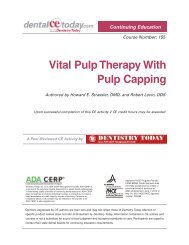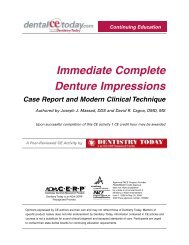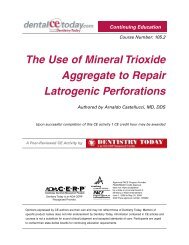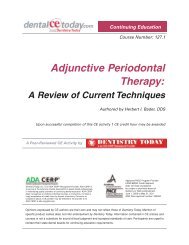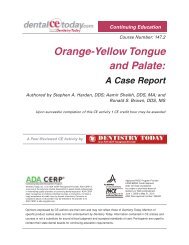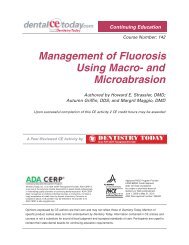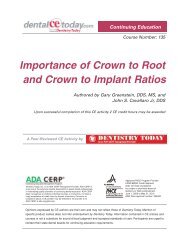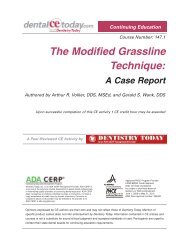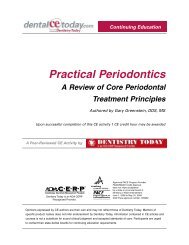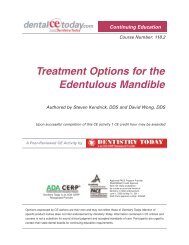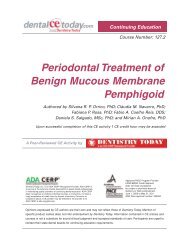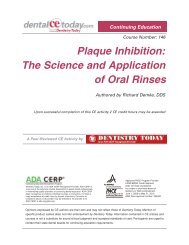Drug-Induced Black Hairy Tongue: Diagnosis and - DentalCEToday
Drug-Induced Black Hairy Tongue: Diagnosis and - DentalCEToday
Drug-Induced Black Hairy Tongue: Diagnosis and - DentalCEToday
You also want an ePaper? Increase the reach of your titles
YUMPU automatically turns print PDFs into web optimized ePapers that Google loves.
Continuing Education<br />
<strong>Drug</strong>-<strong>Induced</strong> <strong>Black</strong><br />
<strong>Hairy</strong> <strong>Tongue</strong>:<br />
<strong>Diagnosis</strong> <strong>and</strong> Management Challenges<br />
Authored by Davidson Lawoyin, DDS <strong>and</strong> Ronald S. Brown, DDS, MS<br />
Upon successful completion of this CE activity 1 CE credit hour may be awarded<br />
A Peer-Reviewed CE Activity by<br />
Dentistry Today is an ADA CERP<br />
Recognized Provider.<br />
Course Number: 97.1<br />
Approved PACE Program Provider<br />
FAGD/MAGD Credit Approval<br />
does not imply acceptance<br />
by a state or provincial board of<br />
dentistry or AGD endorsement.<br />
June 1, 2006 to May 31, 2009<br />
AGD Pace approval number: 309062<br />
Opinions expressed by CE authors are their own <strong>and</strong> may not reflect those of Dentistry Today. Mention of<br />
specific product names does not infer endorsement by Dentistry Today. Information contained in CE articles <strong>and</strong><br />
courses is not a substitute for sound clinical judgment <strong>and</strong> accepted st<strong>and</strong>ards of care. Participants are urged<br />
to contact their state dental boards for continuing education requirements.
<strong>Drug</strong>-<strong>Induced</strong> <strong>Black</strong><br />
<strong>Hairy</strong> <strong>Tongue</strong>:<br />
<strong>Diagnosis</strong> <strong>and</strong> Management<br />
Challenges<br />
LEARNING OBJECTIVES:<br />
After reading this article, the individual will learn:<br />
• The etiology, clinical presentation, <strong>and</strong> diagnosis<br />
of BHT.<br />
• A management protocol for treating BHT.<br />
ABOUT THE AUTHORS<br />
Dr. Brown is a professor within the<br />
Department of Oral Diagnostic Services<br />
at Howard University College of<br />
Dentistry <strong>and</strong> an associate clinical<br />
professor within the department of<br />
Otolaryngology at Georgetown<br />
University Medical Center, Washington, DC. He can be<br />
reached at (202) 806-0349 or rbrown@howard.edu.<br />
INTRODUCTION<br />
Dr. Lawoyin is an associate professor<br />
within the Department of Oral &<br />
Maxillofacial Surgery at Howard<br />
University College of Dentistry,<br />
Washington, DC. He can be reached<br />
at dlawoyin@howard.edu.<br />
“<strong>Black</strong> hairy tongue” (BHT), also known as lingua<br />
villosa nigra, hyperkeratosis of the tongue, nigrities linguae,<br />
keratomycosis linguae, <strong>and</strong> melanotrichia linguae, is a<br />
benign disorder characterized by hypertrophy of the filiform<br />
papillae. Lusitanus, who is credited with the original<br />
description of black hairy tongue, reported this condition in<br />
1557. He reported finding hairs of the tongue which would<br />
regrow upon being removed. 1-8 There are a number of<br />
1<br />
Continuing Education<br />
Recommendations for Fluoride Varnish Use in Caries Management<br />
precipitating factors. The etiology of this condition is most<br />
commonly due to the side effects of certain drugs, including<br />
antibiotics, antihypertensives, psychotropics, <strong>and</strong><br />
oxygenating oral mouth rinses. Oxidizing agents include<br />
sodium perborate, sodium peroxide, <strong>and</strong> hydrogen<br />
peroxide. Tobacco use, poor oral hygiene, <strong>and</strong> various<br />
stains related to certain foods <strong>and</strong> beverages have also<br />
been related to the occurrence of BHT, but not in regard to<br />
the case report described in this article. 5-8<br />
When patients are using multiple medications, it is<br />
necessary for the clinician to investigate the potential causes<br />
by gathering an accurate history <strong>and</strong> using that information<br />
to gain an underst<strong>and</strong>ing of this condition. A case is<br />
presented in which a patient developed black hairy tongue<br />
following exposure to multiple pharmacological agents.<br />
ETIOLOGY, DIAGNOSIS, AND TREATMENT<br />
Even though the cause of BHT is unknown, several<br />
precipitating factors have been implicated in the<br />
pathogenesis of the disease entity. The hairy appearance is<br />
due to the elongation of keratinized filiform papillae, which<br />
may have different colors varying from white, yellow, brown,<br />
to black depending upon the involved extrinsic factors<br />
(ie, tobacco, coffee, tea, or food) <strong>and</strong> intrinsic factors<br />
(ie, chromogenic organisms in the normal flora). 2,3 In 1925,<br />
Prinz 4 suggested that BHT results from a predisposition<br />
of the surface of the tongue to irritation by specific<br />
substances. Accordingly, the irritation leads to hypertrophy<br />
of the filiform papillae, <strong>and</strong> the enlarged papillae become<br />
easily stained with available pigments. Prinz opined that the<br />
main source of the pigments was a local reaction between<br />
the decomposition products of food <strong>and</strong> iron (secondary to<br />
blood within the mouth). In verifying his hypothesis, he<br />
applied an irritant twice daily to the tongues of 6 students.<br />
Within a week, one student showed a slight enlargement of<br />
the filiform papillae of the tongue. The student then<br />
intentionally slightly injured his gingiva with a toothpick to<br />
allow blood to contaminate the elongated tongue papillae.<br />
A marked enlargement of the papillae with a deep brown<br />
stain was noted. Since 1925, knowledge of the etiology of<br />
BHT has not improved markedly. 1,5 Several authors have<br />
suggested that black discolorations result from the growth<br />
of pigment-producing organisms in the oral cavity. 6,7
BHT is not difficult to diagnose. However, the etiology<br />
of this condition is poorly understood, <strong>and</strong> successful<br />
therapy may prove challenging. Powell 8 suggested that it<br />
is necessary to distinguish between true hairy tongue <strong>and</strong><br />
“pseudo-hairy tongue” in the sense that in the latter there is<br />
brownish-black discoloration of the tongue without the<br />
exaggerated elongation of the filiform papillae.<br />
Marabe, et al 9 suggested that the condition seems to<br />
be related to either increased keratin deposition or delayed<br />
shedding of the cornified layer. The discoloration may vary<br />
from yellow to brown to black. The discoloration <strong>and</strong><br />
elongation of the filiform papillae usually involves the<br />
anterior <strong>and</strong> middle thirds of the dorsal tongue. Factors<br />
associated with BHT include drugs such as antibiotics<br />
(penicillin, cephalosporin, chloramphenicol, streptomycin,<br />
<strong>and</strong> tetracycline), corticosteroids, oxygenating mouth<br />
rinses, nonsteroidal anti-inflammatory drugs <strong>and</strong><br />
psychotropics, as well as tobacco, vegetable dyes,<br />
radiation, <strong>and</strong> most importantly, poor oral hygiene. 10-12 BHT<br />
is also observed with much greater frequency in drug<br />
addicts, alcoholics, <strong>and</strong> patients infected with the human<br />
immunodeficiency virus. 11<br />
The medications noted above also have other oral side<br />
effects, which can include xerostomia, stomatitis,<br />
sublingual adenitis, <strong>and</strong> parotid swelling. 13 Other<br />
contributing factors include antacids, toothpaste containing<br />
neomycin, <strong>and</strong> radiation therapy. 9-12 The discontinuation of<br />
smoking, oxygenating mouth rinses, <strong>and</strong> antibiotics will<br />
usually result in resolution of the condition. 10 According to<br />
various studies, 13-16 the incidence of BHT ranges from<br />
0.5% in the United States to 12.8% reported in a population<br />
of Israel male geriatric patients, <strong>and</strong> up to 57% within a<br />
population of imprisoned Greek drug addicts. There is no<br />
racial predilection to BHT, <strong>and</strong> even though it is reported<br />
more often in males, it is not uncommon in females,<br />
especially those who drink coffee or tea, <strong>and</strong>/or those who<br />
use tobacco. Also, the incidence <strong>and</strong> the prevalence of<br />
hairy tongue increases with age, possibly because a higher<br />
percentage of the population engage in activities (eg, using<br />
tobacco, drinking coffee or tea) that predispose to the<br />
condition. 16<br />
Sarti, et al 5 noted that certain suggested treatments for<br />
BHT have been mentioned as possible causative agents.<br />
They suggest that all predisposing factors should be<br />
eliminated <strong>and</strong> the dorsum of the tongue should be brushed<br />
twice daily using 3% hydrogen peroxide or baking soda.<br />
Other authors have suggested topical triamcinolone<br />
acetonide (ie, Kenalog, Aristocort) twice daily after wiping<br />
the tongue dry, while others have recommended topical<br />
antifungal agents. 5-8<br />
CASE REPORT<br />
Continuing Education<br />
<strong>Drug</strong>-<strong>Induced</strong> <strong>Black</strong> <strong>Hairy</strong> <strong>Tongue</strong>: <strong>Diagnosis</strong> <strong>and</strong> Management Challenges<br />
2<br />
A 68-year-old male presented to a dental specialty<br />
clinic with chief complaint of “black tongue.” The condition<br />
was observed first by the patient’s otolaryngologist<br />
approximately 9 months previously. The patient was being<br />
treated for a sinus infection <strong>and</strong> was taking several<br />
antibiotics at the time. The physician prescribed an overthe-counter<br />
mouth rinse which was not effective in<br />
decreasing or eliminating the condition. The patient was<br />
referred to another physician who recommended a<br />
probiotic (a dietary supplement containing potentially<br />
beneficial bacteria, acidophilus, or yeast, which is also<br />
found in yogurt), which did not help. On his own, the patient<br />
attempted a combination of mouth scraping <strong>and</strong> baking<br />
soda, but also to no avail. The condition persisted for 6<br />
months after antibiotic therapy had been discontinued. The<br />
condition waxed <strong>and</strong> waned but never completely resolved.<br />
The medical history appeared to be contributory, due to<br />
the probability that one or more of the patient’s medications<br />
may have influenced the condition. The medical history was<br />
positive for atrial tachycardia, for which the patient was taking<br />
coumadin, irbesartan, labetalol, digoxin, <strong>and</strong> simvastatin. The<br />
patient was also taking flunisolide <strong>and</strong> loratadine for nasal<br />
congestion, <strong>and</strong> providone-iodine, hydrogen peroxide, <strong>and</strong> a<br />
commercial mouth rinse with essential oils <strong>and</strong> alcohol for oral<br />
hygiene, in conjunction with brushing <strong>and</strong> flossing. He had<br />
prostate cancer surgery 4 years previously, for which he was<br />
being monitored. Further, there was a history of penicillin <strong>and</strong><br />
pollen allergy. The patient did not smoke but noted moderate<br />
drinking of alcohol, particularly red <strong>and</strong> white wines.<br />
Clinical examination revealed no regional lymphadenopathy.<br />
The posterior <strong>and</strong> middle dorsal tongue was<br />
noted for a black hairy tongue appearance (Figure 1). The<br />
posterior <strong>and</strong> middle thirds had black staining of the filiform
papillae. The left parotid salivary gl<strong>and</strong> did not demonstrate<br />
function, while the right parotid gl<strong>and</strong> demonstrated limited<br />
function. The subm<strong>and</strong>ibular salivary gl<strong>and</strong>s <strong>and</strong> minor<br />
salivary gl<strong>and</strong>s of the lips demonstrated normal function.<br />
The remaining oral tissues appeared to be within normal<br />
limits. The patient was presently utilizing a tongue scraping<br />
device.<br />
A diagnosis of “black hairy tongue” <strong>and</strong> “relative<br />
xerostomia” was made, <strong>and</strong> treatment recommendations<br />
were offered in the following order. The recommended<br />
therapy was to discontinue the commercial mouth rinse <strong>and</strong><br />
periodontal antibacterial therapy, use the tongue scraper<br />
twice a day (rather than only once a day), <strong>and</strong> to begin dry<br />
mouth therapy which consisted of forcing fluids, drinking<br />
<strong>and</strong> sipping water, <strong>and</strong> the utilization of dry mouth products<br />
such as a salivary replacement gel. Furthermore, it was<br />
suggested to discontinue the use of toothpastes with<br />
additives such as triclosan <strong>and</strong> whiteners, as these<br />
additives can be caustic. 17,18<br />
The patient returned for a follow up appointment 2<br />
weeks later. The condition had improved remarkably<br />
(Figure 2). It was the patient’s opinion that the improvement<br />
was mainly due to discontinuing the use of the oral rinses.<br />
DISCUSSION<br />
The antibiotics utilized for the treatment of the patient’s<br />
sinusitis may well have been one of the initiating factors of<br />
the BHT. Since the use of antibiotics had stopped 6 months<br />
earlier, these drugs could be eliminated as a continuation<br />
factor. It is likely that the concomitant use of oral rinses may<br />
well have compounded the pre-existing condition.<br />
Prolonged use of oxidizing agents such as sodium<br />
perborate, sodium peroxide, <strong>and</strong> hydrogen peroxide<br />
commonly contained in mouth washes have been<br />
associated with BHT. 5,7,12 The efficacy of tongue scraping<br />
to remove black hairy tongue <strong>and</strong> other coatings has been<br />
reported, 12,14 <strong>and</strong> may have helped resolve the condition,<br />
although this activity was increased <strong>and</strong> not initiated. The<br />
treatment of the patient’s relative xerostomia may have<br />
been beneficial with regard to his BHT.<br />
The approach to treatment of BHT can vary. Of course,<br />
smoking cessation <strong>and</strong> attention to oral hygiene are<br />
advocated, but these were not factors in this case. Other<br />
investigators 19,20 have suggested such therapies as topical<br />
podophyllin <strong>and</strong> tretinoin. However, both of these topical<br />
treatments have problematic side effects. The patient was<br />
advised to discontinue oxygenating mouth rinses, <strong>and</strong> the<br />
patient believed that discontinuing the mouth rinses was<br />
particularly helpful.<br />
CONCLUSION<br />
Continuing Education<br />
<strong>Drug</strong>-<strong>Induced</strong> <strong>Black</strong> <strong>Hairy</strong> <strong>Tongue</strong>: <strong>Diagnosis</strong> <strong>and</strong> Management Challenges<br />
Figure 1. Appearance of<br />
patient’s tongue on initial<br />
presentation.<br />
Figure 2. Appearance of<br />
patient’s tongue after<br />
2 weeks of therapy<br />
3<br />
There are many possible causes of BHT. It is important<br />
for the clinician to take an accurate <strong>and</strong> detailed history in<br />
order to determine the most likely causal agents. The<br />
treatment should be individualized, based on the clinician’s<br />
assessment of the etiologic agents. Treatment should<br />
emphasize gentle debridement <strong>and</strong> discontinuing the drugs<br />
<strong>and</strong> rinses which may be precipitating factors. As the use of<br />
an oxygenating mouth rinse is a known causative <strong>and</strong><br />
continuation factor, its discontinuation was strongly<br />
suggested. This case demonstrated successful resolution<br />
of the condition in a patient with a relatively complex history.
REFERENCES<br />
1. Waggoner WC, Volpe AR. Lingua villosa nigra: a review of<br />
black hairy tongue. J Oral Med. 1967; 22:18-21.<br />
2. Haring JI. Case #10. RDH Magazine. Nov 2004; 24:62-70.<br />
3. Tinbos G. Oral changes associated with tobacco use.<br />
Am J Med Sci. 2003;326:179-182.<br />
4. Prinz H. <strong>Black</strong> tongue. Br Dent J. 1925;46:1265-1274.<br />
5. Sarti GM, Haddy RI, Schaffer D, et al. <strong>Black</strong> hairy tongue.<br />
Am Fam Physician. 1990;41: 1751-1755.<br />
6. Pindberg JJ. Disorders of the oral cavity <strong>and</strong> lips. In: Rook<br />
A, ed. Textbook of Dermatology. 4th ed. Vol 3. St Louis, MO:<br />
Mosby-Year Book; 1986: 2117-2120.<br />
7. Van der Waal I, Pindberg JJ, eds. Diseases of the <strong>Tongue</strong>.<br />
Chicago, IL: Quintessence; 1986: 39-55.<br />
8. Powell FC. Glossodynia <strong>and</strong> other disorders of the tongue.<br />
Dermatol Clin. 1987;5:687-693.<br />
9. Manabe M, Lim HW, Winzer M, et al. Architectural<br />
organization of filiform papillae in normal <strong>and</strong> black hairy<br />
tongue epithelium: dissection of differentiation pathways in a<br />
complex human epithelium according to their patterns of<br />
keratin expression. Arch Dermatol. 1999; 135:177-181.<br />
10. Hommes M, Hoskam JA. Diagnostic image (189). A man<br />
with a tongue disorder. <strong>Black</strong> hairy tongue [in Dutch].<br />
Ned Tijdschr Geneeskd. 2004;148:984.<br />
11. Tamam L, Annagur BB. <strong>Black</strong> hairy tongue associated with<br />
olanzapine treatment: a case report. Mt Sinai J Med.<br />
2006;73:891-894.<br />
Continuing Education<br />
<strong>Drug</strong>-<strong>Induced</strong> <strong>Black</strong> <strong>Hairy</strong> <strong>Tongue</strong>: <strong>Diagnosis</strong> <strong>and</strong> Management Challenges<br />
4<br />
12. Abdollahi M, Radfar M. A review of drug-induced oral<br />
reactions. J Contemp Dent Pract. 2003; 4:10-31.<br />
13. American Dental Association. A-Z Topics: Chronic Fatigue<br />
Syndrome. Table 2. Dental-related side effects of medications<br />
commonly prescribed for chronic fatigue syndrome.<br />
www.ada.org/prof/resources/topics/chronicfatique/index.asp.<br />
Accessed November 19, 2007.<br />
14. Regezi JA, Sciubba JJ, Jordan RCK, eds. Oral Pathology:<br />
Clinical Pathologic Correlations. 4th ed. Philadelphia, PA:<br />
Saunders; 2002:85-108.<br />
15. Greenberg MS, Glick M, eds. Burket’s Oral Medicine:<br />
<strong>Diagnosis</strong> <strong>and</strong> Treatment. 10th ed. Hamilton, Ontario,<br />
Canada: BC Decker; 2002: 116-125.<br />
16. Lynch D. <strong>Hairy</strong> tongue. eMedicine Web site.<br />
http://www.emedicine.com/derm/topic639.htm. Updated<br />
December 16, 2006. Accessed August 9, 2007.<br />
17. Kowitz G, Jacobson J, Meng Z, et al. The effects of tartarcontrol<br />
toothpaste on the oral soft tissues. Oral Surg Oral<br />
Med Oral Pathol. 1990; 70:529-536.<br />
18. Skaare A, Kjaerheim V, Barkvoll P, et al. Skin reactions <strong>and</strong><br />
irritation potential of four commercial toothpastes. Acta<br />
Odontol Sc<strong>and</strong>. 1997 ;55:133-136.<br />
19. McGregor JM, Hay RJ. Oral retinoids to treat black hairy<br />
tongue. Clin Exp Dermatol. 1993; 18:291.<br />
20. Langtry JAA, Carr MM, Steele MC, et al. Topical tretinoin:<br />
a new treatment for black hairy tongue (lingua villosa nigra).<br />
Clin Exp Dermatol. 1992; 17:163-164.
POST EXAMINATION INFORMATION<br />
To receive continuing education credit for participation in<br />
this educational activity you must complete the program<br />
post examination <strong>and</strong> receive a score of 70% or better.<br />
Traditional Completion Option:<br />
You may fax or mail your answers with payment to Dentistry Today<br />
(see Traditional Completion Information on following page). All<br />
information requested must be provided in order to process the<br />
program for credit. Be sure to complete your “Payment”, “Personal<br />
Certification Information”, “Answers” <strong>and</strong> “Evaluation” forms, Your<br />
exam will be graded within 72 hours of receipt.. Upon successful<br />
completion of the post-exam (70% or higher), a “letter of<br />
completion” will be mailed to the address provided.<br />
Online Completion Option:<br />
Use this page to review the questions <strong>and</strong> mark your answers.<br />
Return to dentalCEtoday.com <strong>and</strong> signin. If you have not<br />
previously purchased the program select it from the “Online<br />
Courses” listing <strong>and</strong> complete the online purchase process. Once<br />
purchased the program will be added to your User History page<br />
where a Take Exam link will be provided directly across from the<br />
program title. Select the Take Exam link, complete all the program<br />
questions <strong>and</strong> Submit your answers. An immediate grade report<br />
will be provided. Upon receiving a passing grade complete the<br />
online evaluation form. Upon submitting the form your Letter Of<br />
Completion will be provided immediately for printing.<br />
General Program Information:<br />
Online users may login to dentalCEtoday.com anytime in the<br />
future to access previously purchased programs <strong>and</strong> view or print<br />
“letters of completion” <strong>and</strong> results.<br />
POST EXAMINATION QUESTIONS<br />
1. <strong>Black</strong> <strong>Hairy</strong> <strong>Tongue</strong> (BHT) is also known as:<br />
a. keratomycosis linguae.<br />
b. nigrities linguae.<br />
c. hyperkeratosis of the tongue.<br />
d. all of the above.<br />
2. The discoloration <strong>and</strong> elongation of the filiform<br />
papillae seen in BHT usually involves:<br />
a. the lateral borders of the tongue.<br />
b. the anterior third of the dorsal tongue.<br />
c. the anterior <strong>and</strong> middle third of the dorsal tongue.<br />
d. the posterior third of the dorsal tongue.<br />
3. Prolonged use of which oxidizing agent(s) have<br />
been associated with BHT?<br />
a. sodium perborate c. both a <strong>and</strong> b<br />
b. sodium hydroxide d. neither a nor b<br />
4. Some groups of antibiotics have been implicated<br />
as precipitating factors for BHT. Which of the<br />
following antibiotics is NOT in this group?<br />
a. clindamycin c. chloramphenicol<br />
b. penicillin d. cephalosporin<br />
5. The filiform papillae of the tongue are known to<br />
demonstrate different types of coloration due to<br />
the effect of some extrinsic factors. Which of the<br />
following is NOT listed as a possible cause of<br />
staining associated with BHT?<br />
a. tea c. cough medicine<br />
b. tobacco d. coffee<br />
6. In the treatment of BHT the following methods<br />
have been suggested with the EXCEPTION of:<br />
a. brushing of the dorsum of the tongue twice daily<br />
with baking soda.<br />
b. application of topical triamcinolone acetonide<br />
twice daily.<br />
c. utilization of a tongue scraper.<br />
d. application of topical antifungal agent.<br />
7. In achieving a resolution of BHT the discontinuation<br />
of the following factors have been suggested with<br />
the EXCEPTION of:<br />
a. discontinuation of antibiotics.<br />
b. discontinuation of tobacco.<br />
c. discontinuation of nonalcoholic beverages.<br />
d. discontinuation of oxygenating mouth rinses.<br />
8. “Pseudo-hairy tongue” has:<br />
a. a brownish-black discoloration of the tongue without<br />
the exaggerated elongation of the filiform papillae.<br />
b. a yellow discoloration of the tongue <strong>and</strong> an<br />
exaggerated elongation of the filiform papillae.<br />
c. a de-papillated appearance.<br />
Continuing Education<br />
<strong>Drug</strong>-<strong>Induced</strong> <strong>Black</strong> <strong>Hairy</strong> <strong>Tongue</strong>: <strong>Diagnosis</strong> <strong>and</strong> Management Challenges<br />
5<br />
d. a brownish-black discoloration of the tongue with<br />
the exaggerated elongation of the filiform papillae.
PROGRAM COMPLETION INFORMATION<br />
If you wish to purchase <strong>and</strong> complete this activity<br />
traditionally (mail or fax) rather than Online, you must<br />
provide the information requested below. Please be sure to<br />
select your answers carefully <strong>and</strong> complete the evaluation<br />
information. To receive credit you must answer at least six<br />
of the eight questions correctly.<br />
Complete online at: www.dentalcetoday.com<br />
TRADITIONAL COMPLETION INFORMATION:<br />
Mail or Fax this completed form with payment to:<br />
Dentistry Today<br />
Department of Continuing Education<br />
100 Passaic Avenue<br />
Fairfield, NJ 07004<br />
Fax: 973-882-3662<br />
PAYMENT & CREDIT INFORMATION:<br />
Examination Fee: $20.00 Credit Hours: 1.0<br />
Note: There is a $10 surcharge to process a check drawn on<br />
any bank other than a US bank. Should you have additional<br />
questions, please contact us at (973) 882-4700.<br />
❏ I have enclosed a check or money order.<br />
❏ I am using a credit card.<br />
My Credit Card information is provided below.<br />
❏ American Express ❏ Visa ❏ MC ❏ Discover<br />
Please provide the following (please print clearly):<br />
Exact Name on Credit Card<br />
Credit Card # Expiration Date<br />
Signature<br />
Dentistry Today is an ADA CERP<br />
Recognized Provider.<br />
Continuing Education<br />
<strong>Drug</strong>-<strong>Induced</strong> <strong>Black</strong> <strong>Hairy</strong> <strong>Tongue</strong>: <strong>Diagnosis</strong> <strong>and</strong> Management Challenges<br />
Approved PACE Program Provider<br />
FAGD/MAGD Credit Approval<br />
does not imply acceptance<br />
by a state or provincial board of<br />
dentistry or AGD endorsement.<br />
June 1, 2006 to May 31, 2009<br />
AGD Pace approval number: 309062<br />
/<br />
PERSONAL CERTIFICATION INFORMATION:<br />
Last Name (PLEASE PRINT CLEARLY OR TYPE)<br />
First Name<br />
Profession / Credentials License Number<br />
Street Address<br />
Suite or Apartment Number<br />
City State Zip Code<br />
Daytime Telephone Number With Area Code<br />
Fax Number With Area Code<br />
E-mail Address<br />
ANSWER FORM: COURSE #: 97.1<br />
Please check the correct box for each question below.<br />
1. ❏ a ❏ b ❏ c ❏ d 5. ❏ a ❏ b ❏ c ❏ d<br />
2. ❏ a ❏ b ❏ c ❏ d 6. ❏ a ❏ b ❏ c ❏ d<br />
3. ❏ a ❏ b ❏ c ❏ d 7. ❏ a ❏ b ❏ c ❏ d<br />
4. ❏ a ❏ b ❏ c ❏ d 8. ❏ a ❏ b ❏ c ❏ d<br />
PROGRAM EVAUATION FORM<br />
Please complete the following activity evaluation questions.<br />
Rating Scale: Excellent = 5 <strong>and</strong> Poor = 0<br />
Course objectives were achieved.<br />
Content was useful <strong>and</strong> benefited your<br />
clinical practice.<br />
Review questions were clear <strong>and</strong> relevant<br />
to the editorial.<br />
Illustrations <strong>and</strong> photographs were<br />
clear <strong>and</strong> relevant.<br />
Written presentation was informative<br />
<strong>and</strong> concise.<br />
How much time did you spend reading<br />
the activity & completing the test?



